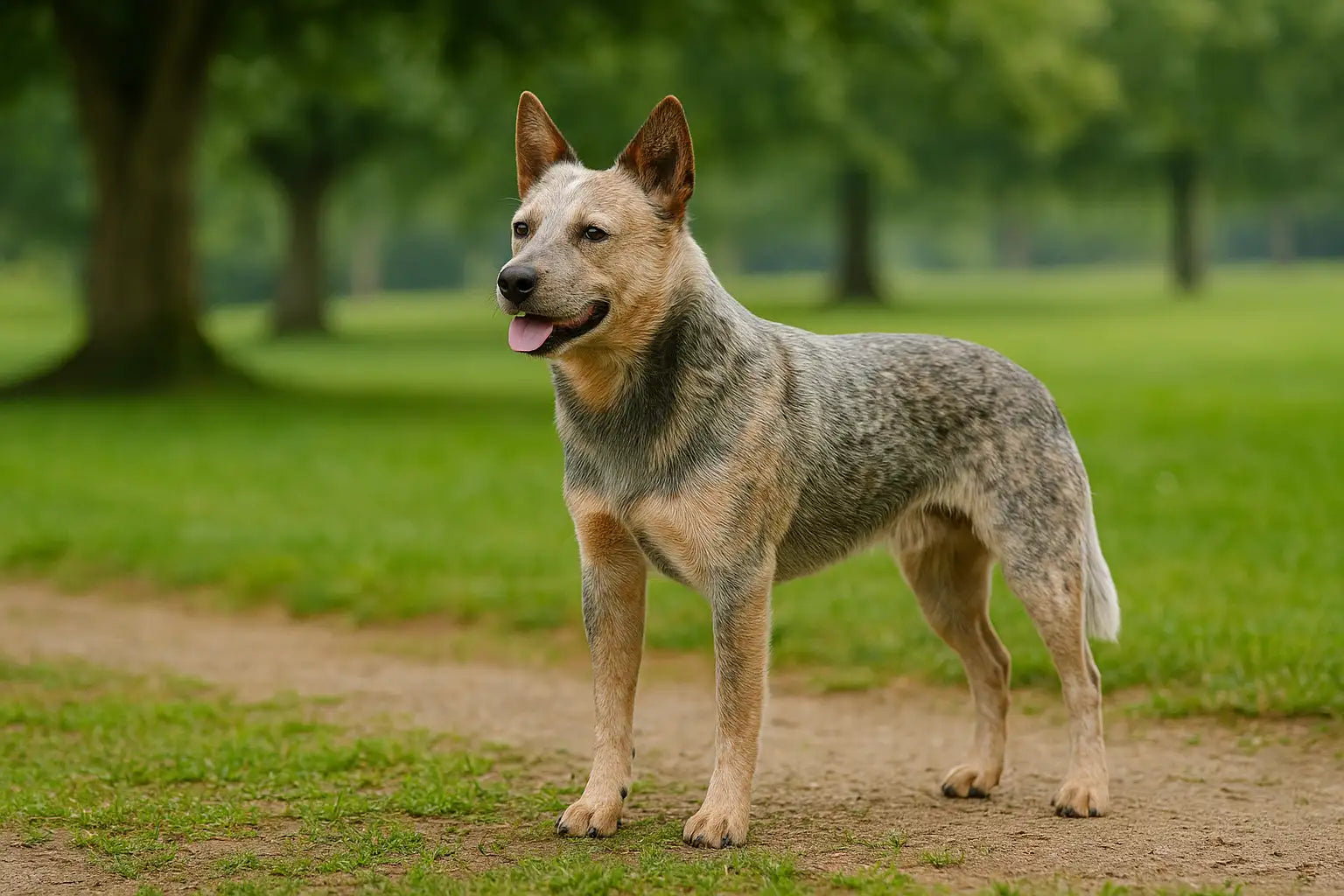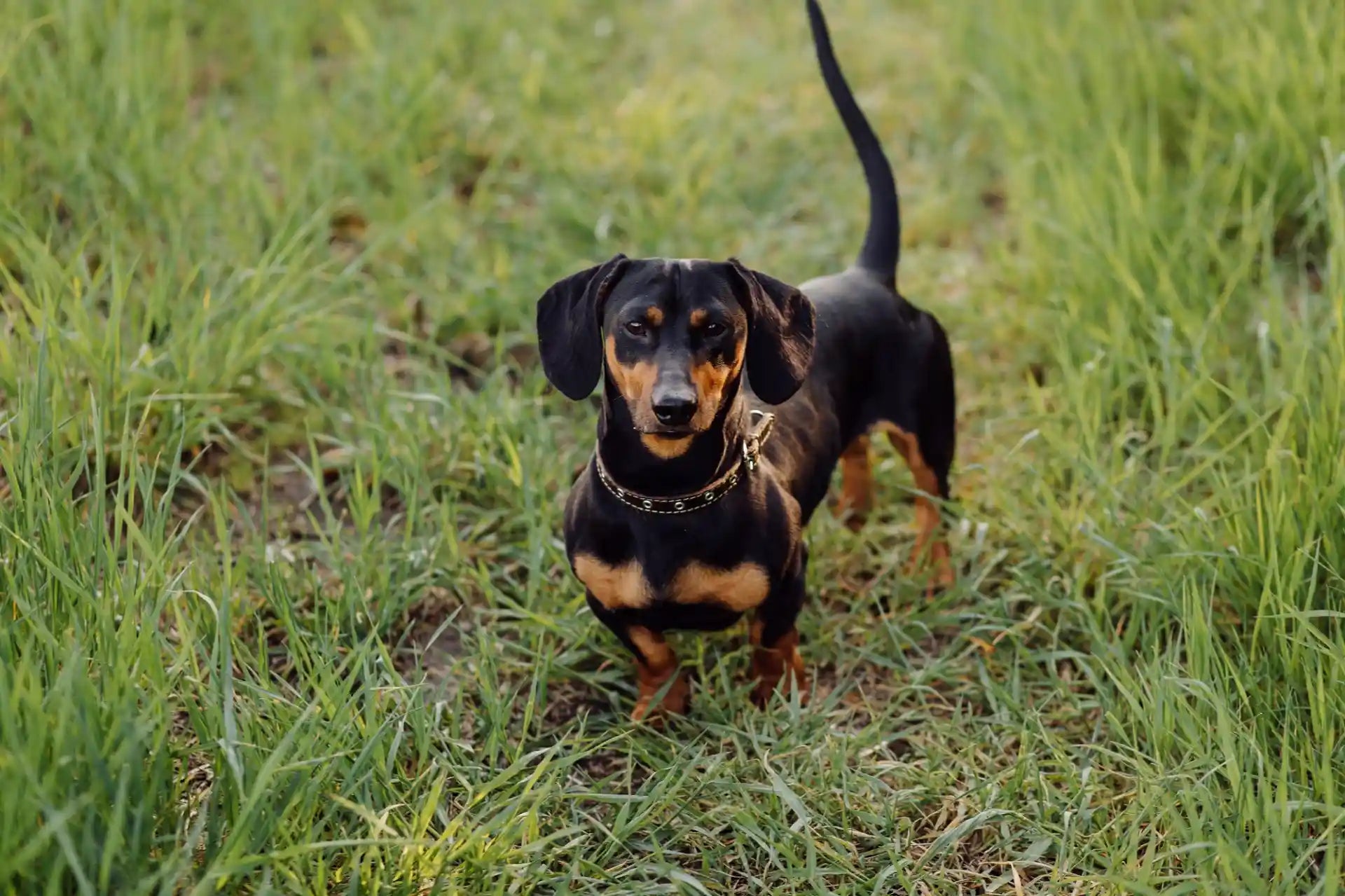
Australian Stumpy Tail Cattle Dog: History, Care, Training & Health Insights By a Trusted Vet
Quick Facts Overview
|
Trait |
Details |
|
Size Category |
Medium |
|
Height & Weight |
43–51 cm; 16–23 kg |
|
Coat Type & Colours |
Short, dense double coat; blue or red speckled |
|
Energy Level |
Very High |
|
Origin |
Australia |
|
Grooming Needs |
Low |
|
Temperament |
Loyal, alert, independent, energetic |
|
Trainability |
High (needs firm, consistent handling) |
|
Compatibility |
Best with experienced owners, good with active families |
|
Lifespan |
12–15 years |
Breed Origins and History
The Australian Stumpy Tail Cattle Dog is a true-blue Aussie breed. Developed in the early 1800s, this working dog was bred for herding cattle across harsh and wide terrain. Unlike its cousin, the Australian Cattle Dog, the Stumpy has a naturally bobbed tail—hence the name. This no-nonsense breed has always been prized for its endurance, intelligence and unwavering work ethic on the land.
Personality and Temperament
If you’re looking for a fiercely loyal and independent mate, the Stumpy might be for you. They’re not lapdogs, and they won’t follow you around for cuddles—but they will guard your home, stick by your side on a hike, and thrive when given a job to do. They can be aloof with strangers but bond closely with their family.
Trainability and Intelligence
These dogs are sharp, focused, and built for work. With the right training, they’ll pick things up fast—but they’re not pushovers. They do best with confident owners who offer structure, routine, and mental stimulation.
-
Learn commands quickly when training is consistent
-
Respond best to praise, work-driven tasks, or toys
-
May test boundaries if bored or under-stimulated
-
A secure training harness and long training leash are great tools
-
Keep high-value rewards in a treat bag for motivation
Exercise and Activity Requirements
These dogs are working machines. If they don’t get enough activity, they’ll find their own jobs—like digging holes, herding your kids, or chewing the fence.
-
Minimum 60–90 minutes of exercise per day
-
Love running, hiking, herding games, and agility
-
Thrive with structured activities and problem-solving tasks
-
Not suited to sedentary households
-
A hands-free lead is ideal for long-distance walks or jogs
-
Consider a dog life jacket if they enjoy swimming
Physical Characteristics
The Stumpy Tail has a tough, athletic body built for endurance. They’re leaner and more leggy than the standard Australian Cattle Dog, with a signature short tail and sharp expression.
-
Height: 43–51 cm
-
Weight: 16–23 kg
-
Coat: Short, weather-resistant double coat
-
Colours: Blue speckled or red speckled with or without markings
-
Most wear medium-sized gear comfortably
Living Environment Suitability
These dogs are built for wide open spaces. They’re best suited to homes with large yards or rural properties where they can run and explore freely. They’re not a great match for apartments or indoor-only lifestyles.
-
Thrive in homes with acreage or space to roam
-
Need a secure yard—they’re known escape artists
-
Handle Aussie weather well with minimal fuss
-
A comfy outdoor-safe bed and car harness help keep them safe and relaxed in transit
Grooming and Maintenance
One of the easier dogs to maintain, the Stumpy’s coat is wash-and-wear. Just give them a good brush now and then to keep shedding under control and their skin healthy.
-
Brush weekly, more during shedding seasons
-
Bathe every 1–2 months or when dirty
-
Trim nails monthly and check ears for debris
-
No fancy cuts or trims needed
-
Pair with a durable soft collar for daily wear
Common Health Issues
This breed is generally hardy, but like all dogs, they can be prone to some inherited health conditions. Early testing and a healthy lifestyle help reduce the risk.
-
Possible issues: hip dysplasia, deafness, progressive retinal atrophy (PRA)
-
Joint care is important for working or very active dogs
-
Watch for skin allergies or sensitivity to fleas
-
Provide a supportive orthopaedic bed to ease pressure on hips and joints in older dogs
Diet and Feeding Guidelines
Stumpies do well on a high-quality, protein-rich diet that matches their activity level. Overfeeding can lead to joint strain, so portion control matters.
-
Puppies: ¾ to 1¼ cups per day, split across 3 meals
-
Adults: 1½ to 2½ cups per day, split into 2 meals
-
Choose foods with joint, coat and energy support
-
Always keep water accessible, especially after exercise
-
Food and water travel kits are handy for long outings
Compatibility with People and Other Pets
This isn’t your average companion dog. They’re loyal to their family but may not be naturally affectionate. With proper training and socialisation, they can live peacefully with other pets—but they’ll always prefer a job over downtime.
-
Loyal and protective with their people
-
Can be reserved or dominant with unfamiliar dogs
-
Good with older kids who respect boundaries
-
Early exposure to other animals is key
-
Use a coupler lead if walking with another dog
Behavioural Issues and Management
Without proper exercise or structure, the Stumpy can be a handful. But with routine, challenge, and guidance, they’ll reward you with unwavering loyalty and drive.
-
Barking or herding behaviour when under-stimulated
-
Destructive habits like digging or chewing
-
Independent nature may test boundaries
-
Use a no-pull harness for focused walking
-
Keep them mentally occupied with chew-resistant toys
Essential Gear for Stumpies
Working & Outdoor Life
Comfort & Travel
Adventure Ready
Training & Support
FAQs: Australian Stumpy Tail Cattle Dog
1. What is the difference between a Stumpy Tail and a Cattle Dog?
The biggest difference is the tail. The Australian Stumpy Tail Cattle Dog is born with a naturally short or “stumpy” tail, while the Australian Cattle Dog usually has a full-length tail. Stumpies are also slightly leaner, more reserved, and bred solely for work, making them a bit more intense in energy and independence.
2. Do Stumpy Tail Cattle Dogs shed?
Yes, they shed. Their short double coat is weather-resistant but will shed lightly year-round and more during seasonal changes. Weekly brushing helps control loose hair and keeps their coat healthy.
3. Are Stumpy Tail Cattle Dogs aggressive?
Not aggressive, but definitely assertive and protective. They can be wary of strangers and other animals, especially without early socialisation. They're incredibly loyal to their family and make excellent watchdogs.
4. Are Australian Stumpy Tail Cattle Dogs good pets?
They’re fantastic pets for experienced and active owners who enjoy training and outdoor activities. These dogs need structure and stimulation but will reward you with loyalty and unmatched work ethic.
5. What is the temperament of a Stumpy Tail Cattle Dog?
They’re alert, independent, intelligent, and loyal. While they may not be overly cuddly, they form strong bonds with their family. They’re best for owners who understand working breeds and can give them a job or regular challenge.
6. Do Australian Cattle Dogs and Stumpy Tails behave the same?
They share similar traits, but the Stumpy Tail is generally more reserved and intense. They’re both energetic and smart, but Stumpies tend to be more independent and less social with strangers.
7. How long do Stumpy Tail Cattle Dogs live?
With good care, they typically live between 12 and 15 years. Regular exercise, a healthy diet, and routine vet visits can help them enjoy a long and active life.
8. Can Stumpy Tail Cattle Dogs be left alone?
They can handle short periods alone, but they don’t do well if left alone all day without mental and physical stimulation. Boredom can lead to destructive behaviour, so they need engagement and purpose.
9. Do Stumpy Tail Cattle Dogs bark a lot?
They will bark when alerting to something unusual, but they’re not excessive barkers by nature. If they’re barking a lot, it’s usually a sign they’re under-exercised or understimulated.
10. What is the best environment for a Stumpy Tail Cattle Dog?
They do best in rural or suburban homes with space to run and a job to do. They're not suited to apartment living or sedentary households. A secure yard and active owner make a world of difference for this breed.
Final Thoughts
The Australian Stumpy Tail Cattle Dog is a true working dog—built for the Aussie outback but adaptable to active, experienced homes. If you’re up for the challenge, you’ll gain a loyal, capable mate who’s always ready to go.
Looking for gear tough enough for your Stumpy?
Visit EzyDog to find rugged, reliable accessories made for working dogs with energy to burn.





Leave a comment
This site is protected by hCaptcha and the hCaptcha Privacy Policy and Terms of Service apply.